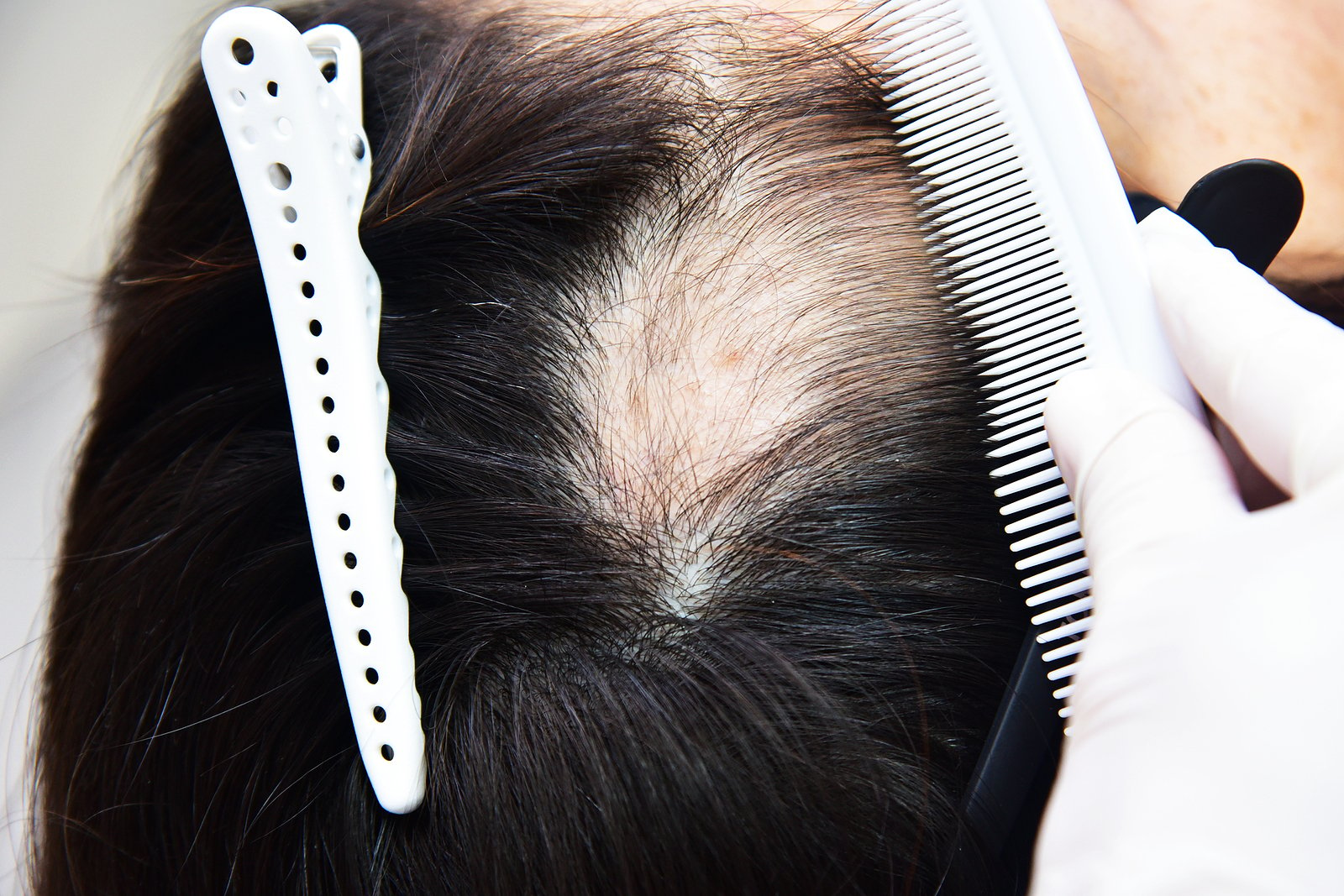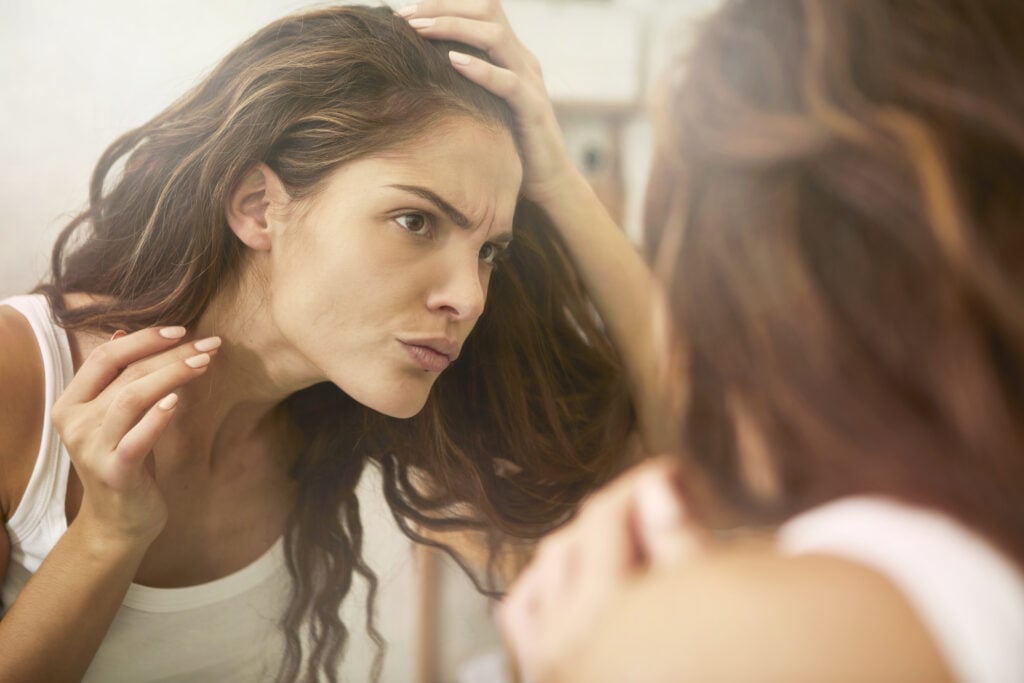
What Causes Women’s Hair Thinning?
While thinning hair is something often associated with men, high numbers of women experience this issue too. About 20% of women in the UK have reported hair thinning before the age of 50, and this figure rises to 65% after menopause. In this article, we will outline the differences between hair thinning and hair loss in women, along with the most common causes, and the treatments available.
Summary
- Women’s Hair Thinning vs Women’s Hair Loss
- Reasons for Women’s Hair Thinning
- Treatment for Women’s Hair Thinning
- Conclusion
Women’s Hair Thinning vs Women’s Hair Loss
Women’s hair loss and hair thinning are frequently used interchangeably when referring to a variety of hair health issues. As a result, many women find it difficult to distinguish between hair thinning vs balding. There is a distinct difference between loss and thinning, however. Hair loss in women, such as female pattern baldness, refers to the hair strands actually falling out from your scalp and detaching from their root. Hair thinning might visibly register as loss, but here the follicles themselves have thinned, while still remaining intact and attached to the root.
In the case of female hair thinning, the affected follicles are thinner, shorter and lack pigment, but still remain in the growth phase. This means that the hair can appear almost invisible to the naked eye, however it is still present on the scalp. Over time, though, the follicle will stop growing and producing new hairs. Therefore, it is not uncommon for the two issues to overlap.
Hair Shedding Pattern

Compared to male thinning, the pattern in women’s hair thinning is less distinct and can typically be more difficult to track. With female hair thinning, the hair will thin all over the scalp and can progress for decades, becoming steadily more severe.
This can appear as a widening of your hairline parting at the top of your scalp and spreading out in a Christmas tree pattern. If you try to tie your hair in a ponytail, it will feel less dense and require more twists to hold in place.
Similar to skin, as you age, your hair will lose its elasticity. This means that the hair will not be as strong as it once was and will lack the ability to withstand harsh cosmetic treatments or hairstyles.
Reasons for Women’s Hair Thinning
Women’s hair can thin for a number of reasons. Some of the most common include:
- Genetics: Female pattern hair loss (androgenetic alopecia) can result in hair thinning. This condition is hereditary, and thus depends on your family history. The shrunken hair follicles can be observed with a biopsy to provide a diagnosis or viaa general examination.
- Hormone levels: Thyroid disorders are common causes of hair thinning in women, and both high and low levels of thyroid hormones can result in the hair thinning. Blood tests with your GP should confirm if this is the cause. With menopause and PCOS (polycystic ovary syndrome), the male hormones in the body increase, causing hair shedding to become more prominent.
- Autoimmune conditions: Diffuse thinning can be a symptom of conditions like alopecia areata incognita, where the hair sheds suddenly and in an erratic pattern. This is due to the immune system mistakenly attacking the hair follicles, causing them to weaken.
- Stress: If your body undergoes a stressful event, either because of a physical or emotional trauma, hair can shed as a reaction. Here, the body prioritises sending nutrients to your vital organs over non-essential functions like hair growth. The hair does not receive the nutrients it needs and can become weak.
Treatment for Women’s Hair Thinning
Scarring vs Non-Scarring
Before you’re able to receive treatment, it's important to classify if your hair thinning is scarring or non-scarring. Some hair thinning conditions, like wearing tight hairstyles for a long time, can cause scarring that destroys the follicles. In these cases, the damage is irreversible and new hairs cannot grow naturally from the follicle again. Thankfully, many conditions that cause chronic hair loss do not result in scarring, meaning that the hair loss may be correctable.
Options for Treatment
Understanding the source of your hair shedding will provide you with the best care for your individual situation. That is why diagnosis and treatment go hand in hand when it comes to regrowing hair. Here are some of the most popular treatments for women’s hair shedding:
- Hair surgery: If you are experiencing long term hair shedding and are looking for a permanent solution, a hair transplant for women is the best option. By taking healthy hair follicles from the back of your head and putting them in places where your hair is shedding, hair grows stronger in these areas, offering more density and coverage. A hair transplant is also the only solution available for scarring forms of hair loss in order to restore hair in those areas.
- Topical medication: Treatments that are applied directly to the affected area, such as Minoxidil, have shown positive results in halting hair shedding. There are some risks are related with the solution though, including dryness, itching and unwanted hair growth on the face. Additionally, it cannot be used during pregnancy or when breastfeeding.
- Prescription medication: While popular male oral medication Finasteride has not been okayed for treatment in women, Spironolactone can be prescribed. This diuretic has been shown to help with hair growth, but it can cause problems if you are already experiencing issues with your kidneys and adrenal glands.
- Supplements and diet: Hair shedding can also be the result of a poor diet or a nutrient deficiency. Your hair needs a variety of vitamins and minerals in order to grow healthily. Consulting your GP will let you know if you have a deficiency. Additionally, a balanced diet should help with maintaining a healthy hair care routine. In particular, Biotin & Keratin are well known to support the growth of your hair and thickens its structure, helping to combat hair shedding.
Conclusion
Women’s hair shedding presents differently to hair loss and needs its own treatment plan. It's important to diagnose the source of the shedding in order to correctly treat it. Whether it's because of genetics, stress or a medical condition, there may be different treatment options available to you.
Are you worried about persistent hair shedding? Then contact one of our experts today, and we’ll let you know if you are suited for a hair transplant. Benefit from a free hair analysis to learn more about how to get a full head of hair again.
FAQ
What are some natural remedies for hair thinning in women?
Natural remedies include essential oils, scalp massages, and a diet rich in vitamins and minerals like iron, zinc, and vitamin E.
How can lifestyle changes impact hair thinning?
Reducing stress through mindfulness and relaxation techniques, improving sleep quality, and avoiding harsh hairstyles can help reduce hair thinning.
Are there specific hairstyles that can help conceal thinning hair?
Yes, hairstyles such as layers, pixie cuts, and bobs can add volume and conceal thinning areas. Using hair accessories and volumizing products can also be beneficial.
Can hair thinning be a side effect of medication?
Yes, certain medications like blood thinners, antidepressants, and chemotherapy drugs can cause hair thinning as a side effect.
Is it possible to prevent hair thinning?
While not all cases can be prevented, maintaining a healthy lifestyle, avoiding excessive heat and chemical treatments, and using gentle hair care products can help reduce the risk of hair thinning.


